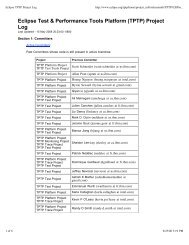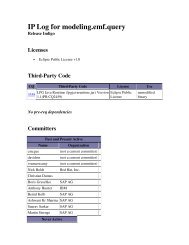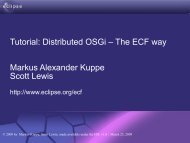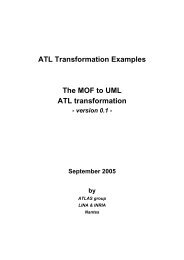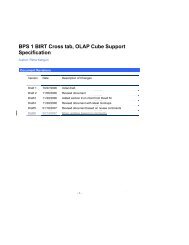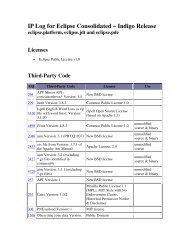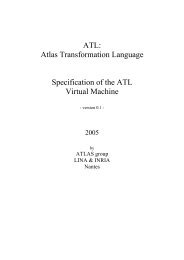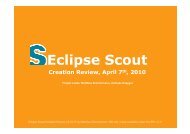ATL Transformation Examples The SSL to SDL ATL ... - Eclipse
ATL Transformation Examples The SSL to SDL ATL ... - Eclipse
ATL Transformation Examples The SSL to SDL ATL ... - Eclipse
Create successful ePaper yourself
Turn your PDF publications into a flip-book with our unique Google optimized e-Paper software.
www.soluta.net<br />
1 Abstract<br />
<strong>ATL</strong><br />
TRANSFORMATION EXAMPLE<br />
Irina Dumitrascu<br />
idumitrascu@soluta.net<br />
Natalia Rebeja<br />
nrebeja@soluta.net<br />
<strong>SSL</strong> <strong>to</strong> <strong>SDL</strong> Date: 20/02/2006<br />
This document describes a transformation which enables <strong>to</strong> create a <strong>SDL</strong> model from a <strong>SSL</strong> model,<br />
using an auxiliary ODM model that contains the on<strong>to</strong>logy elements referred in the <strong>SSL</strong> model.<br />
<strong>SDL</strong> is a language for describing concrete service interfaces, from a technical point of view, while<br />
<strong>SSL</strong> can be used <strong>to</strong> create semantic descriptions of services. <strong>SSL</strong> models can refer <strong>to</strong> terms defined<br />
in an external on<strong>to</strong>logy, therefore another metamodel, ODM, is used for querying on<strong>to</strong>logies.<br />
2 Introduction<br />
<strong>SSL</strong> (Semantic Service Language) is used <strong>to</strong> consistently define service description models for<br />
semantically describing services.<br />
ODM (On<strong>to</strong>logy Definition Metamodel) is used for defining business and service on<strong>to</strong>logies.<br />
<strong>SDL</strong> (Service Description Language) is a language used <strong>to</strong> describe services in a platform<br />
independent way. It allows <strong>to</strong> describe the technical interface of a service.<br />
<strong>The</strong> <strong>SSL</strong> and <strong>SDL</strong> standards are mutually related since a technical interface for a certain service can<br />
be obtained from its semantic description.<br />
<strong>The</strong> three above mentioned standards have been developed for the Digital Business Ecosystem<br />
(DBE) project. Supported by the European Commission’s 6th FP for research and development in<br />
IST, DBE 1 is a 3-year pan-European project involving 120 researchers and specialists from 20<br />
organizations, including some of the important names in the international computing and business<br />
context. <strong>The</strong> goal of the DBE Project is <strong>to</strong> build an open source environment, an Internet-based<br />
ecosystem in which business applications can be developed and used by small <strong>to</strong> medium<br />
enterprises (SMEs). It will enable end users, even those SMEs with low ICT access, <strong>to</strong> easily<br />
interact among each others and use Internet-based business applications as services for expanding<br />
their business and market, getting the benefits of intelligence, interaction and adaptation as the<br />
software evolves in response <strong>to</strong> its usage.<br />
3 <strong>The</strong> <strong>SSL</strong> <strong>to</strong> <strong>SDL</strong> <strong>ATL</strong> transformation<br />
3.1 <strong>Transformation</strong> overview<br />
<strong>The</strong> <strong>SSL</strong> <strong>to</strong> <strong>SDL</strong> transformation converts a <strong>SSL</strong> model in<strong>to</strong> a <strong>SDL</strong> model using an ODM model <strong>to</strong><br />
include the necessary data from an on<strong>to</strong>logy in<strong>to</strong> the technical specification of the service.<br />
3.2 Metamodels<br />
DBE has chosen <strong>to</strong> adopt a MDA based approach using MOF as the meta-meta-model for defining<br />
1 More details can be found at the following website: http://www.digitalecosystem.org/.<br />
3/36



